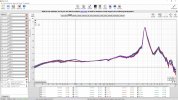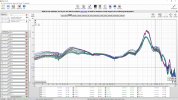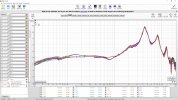- Thread Starter
- #41
Just be safer to use Oratory's latest EQ's from his reddit site, avoid all pitfalls that way.....and he also does update his pdf's from time to time, so best to check his actual site rather than downloading one of his pdf's and assuming it will just stay the same over the course of months or a year.View attachment 274739
Well it says Harman over ear 2018 in Auto EQ in Peace.
Yes, indeed. I need to check what I have saved vs the PDFs on dropbox to make sure I was comparing vs Harman tuning. I have to say, I am a bit disappointed AutoEQ is not reliable as it was very convenient.
I think it's a reasonable suggestion from you to think there could be some relation between positional variability on a measurement fixture vs variability between users, although I don't think you can be certain until the measurements are done on different people. And I agree that if a headphone shows more positional and also more interpersonal variation then as you say you can't be as confident in the fine grained minutia re those particular headphones.It's somewhat related, although I can see why you'd say that. A change in positioning showing a slightly different result isn't exhaustively indicative of the degree of variability on different heads (given the ears and coupling would be different too), however you can still get a sense of how that would change given the differences in default wearing positions across users. As an example, for some headphones, like the HD 560 S, or the Focal closed backs, extremely subtle seating changes can yield distinctly different results. I think we can expect those effects to vary across users as well. Of course, that doesn't include all variables, but it's at minimum an indication that we should probably be less confident about those fine-grained minutia on those headphones versus say... and HD 800 S where the same subtle change doesn't yield any meaningful difference, since they're less predictive as a result.
Re variability of various headphones between reseatings on measurement rigs, I thought I'd quickly drop some pictures showing reseat variability of a number of my headphones, to me the HD560s had the lowest variation between reseats vs my other headphones, and that was including the K702 which has been proven to be very reliable in terms of variation between different people's heads (well the K701 which is the same design was measured in the published study in on head deviation between different heads), so here some quick thumbnails of my headphones measured on my miniDSP EARS (showing all measurements & of both channels on each graph) showing the HD560s to have the least deviation (by eyeball) between reseats and even compared to the K702 which is supposed to be very stable with positioning and between different heads:




These were all measured in a roughly central position to avoid pinna deformation in a bid to replicate how a user would intelligently place a headphone on their own heads, which they'd do with some accuracy as they can feel how their ears sit within the earcup. 20 measurements in all (10 for each channel), and 10 reseats for each headphone. In terms of reseat variation to me it looks like closed back NAD HP50 is clearly the worst with the highest variation between reseats, then open back planar HE4XX, then open back K702, then the best with least reseat variation the open back HD560s. So this does seem to conflict with what you've been saying re HD560s reseat variability vs other headphones.
(I did all these measurements almost exactly 1 year ago)
Last edited:
